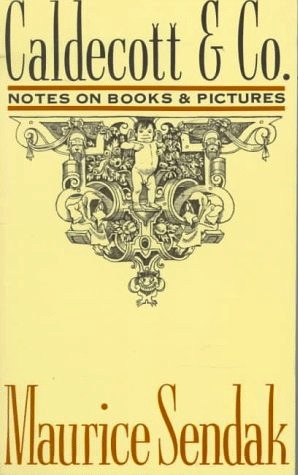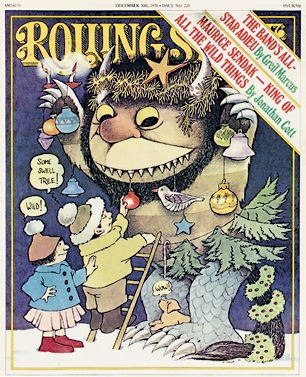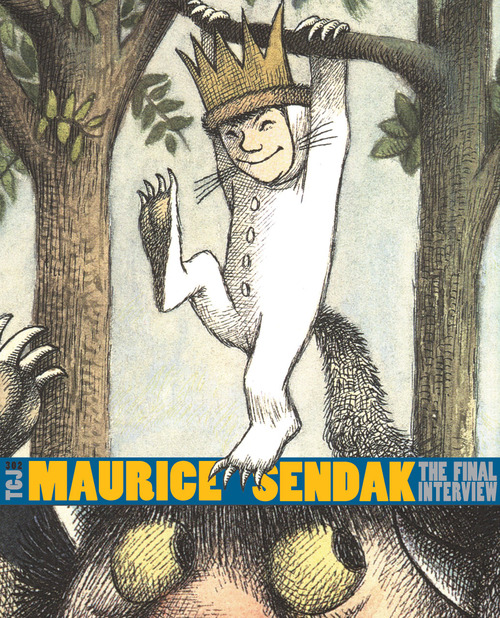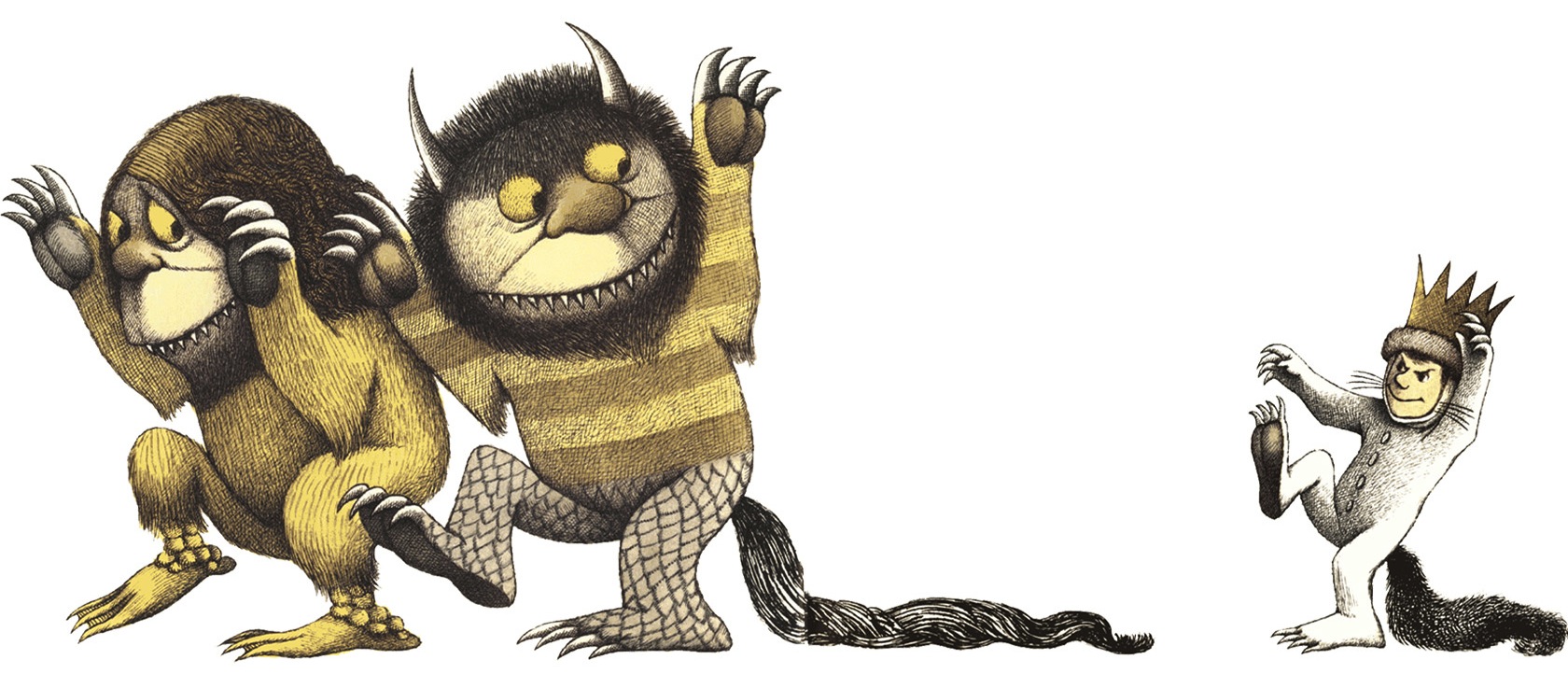It looks like the collected works of Maurice Sendak have exploded all over my office… because I’ve just finished a draft of an article on Sendak – one of many pieces I agreed to write this summer (and one reason why this blog has been so quiet lately). He was one of our most articulate creators of children’s literature, and so I thought I’d share a bit of his collected wisdom here. Also, I generate so many notes when writing an article, and many of them never make it into the final piece. So why not share a small sliver of them with others? To that end, I’m collecting below (1) nine video interviews with or documentaries on Sendak, and (2) nine quotations from interviews with Sendak (including one from an unpublished conversation with me).
Nine Video Interviews/Documentaries
Tell Them Anything You Want: A Portrait of Maurice Sendak. Directed by Lance Bangs and Spike Jonze. HBO Films, 2009.
As I watched this earlier today, I realized that I’d put off watching it because I wasn’t sure if I was ready to see images of Maurice, alive and talking. But it’s been over a year, and I shouldn’t have put it off. Sure, I was a little teary in places, but Sendak is also funny and wonderful. Start with this one. Indeed, if you’ve any interest in Sendak, pick up a copy of the DVD. 40 minutes.
Maurice Sendak on his work, childhood, inspirations. Rosenbach Museum, 2008.
A 10-minute mini-documentary, from the Rosenbach Museum, where Sendak’s papers are held.
A Celebration of Maurice Sendak at the 92nd Street Y. 15 Sept. 2008.
The DVD of Tell Them Anything You Want includes excerpts from this. Here’s the whole thing. It’s 1 hour and 45 minutes in all, but – for those of you with the time and the attention span – it’s well worth your while. After introductory remarks, Eleanor Reissa gives a reading of Where the Wild Things Are in Yiddish. Then, remarks from Eyal Danieli. After that, Spike Jonze, Lance Bangs, and Spike Jonze introduce their dramatization of Sendak at the 1939 World’s Fair, and they show this short film (also included on the DVD of Tell Them Anything You Want). Next, Linda Emond reads (and sings) Outside Over There. Stephen Greenblatt suggests that Caliban (from The Tempest) is the literary ancestor of Max, and makes other connections between Shakepseare’s work and Sendak’s. Stephen Gosling & Elizabeth Keusch present highlights from an operatic adaptation of Higglety Pigglety Pop. That’s followed by a film clip of people from the Pacific Northwest Ballet, who staged The Nutcracker with Sendak’s sets, in 1983. James Gandolfini reads In the Night Kitchen. Next, Dave Eggers offers a tribute to Sendak, and reads from his (Eggers’) adaptation, Wild Things. Chuck Cooper, Aisha de Haas, Kimberly Grigsby, Denis O’Hare & Alice Playten sing “Pierre” from Really Rosie. Meryl Streep reads The Sign on Rosie’s Door, Catherine Keener reads a speech of Sendak’s. Next a video of Sendak’s book covers, interspersed with photos of Sendak himself. Vince Landay (producer of the Wild Things film), Spike Jonze and Max Records (who stars as Max) introduce a minute of the Wild Things film — looks like an early version of the trailer. Finally, a few words from Tony Kushner, an official proclamation from New York City Council Speaker Christine Quinn, and a thank you from Sendak himself.
Maurice Sendak on NOW with Bill Moyers. PBS, 2004.
A full transcript is available on PBS’ website. The second half, in which he discusses Brundibar, is (as you might expect) darker. 17 mins., 40 seconds.
“TateShots: Maurice Sendak.” The Tate Gallery. 2011
Sendak talks about Where the Wild Things Are, Herman Melville, and William Blake. He talks the most about Blake and Outside Over There. 5 minutes.
For more on Blake and Sendak, see Mark Crosby’s annotations, explaining Blake’s influence on My Brother’s Book.
“Maurice Sendak’s Favorite Books.” Martha Stewart Living. April 2000.
A happier Sendak talks about Where the Wild Things Are, Ursula Nordstrom, In the Night Kitchen, his favorite children’s books. Outside Over There. 8 minutes.
“Grim Colberty Tales” The Colbert Report. Comedy Central. 24 and 25 Jan. 2012
“Grim Colberty Tales, Part I”
“Grim Colberty Tales, Part II”
Outtakes, aired 8 May 2012: “Uncensored –Â Maurice Sendak Tribute & ‘I Am a Pole (And So Can You!)’ Release.”
Lively conversations, in which Maurice Sendak suggests that the mouse (in If You Give a Mouse a Cookie) be exterminated, calls Newt Gingrich “an idiot of great renown,” and draws an elderly Polish woman pole-dancing.
“An Illustrated Talk with Maurice Sendak” with drawings by Christoph Neimann. New York Times, Dec. 2012
Using excerpts from Terry Gross’s Sept. 2011 Fresh Air interview with Maurice Sendak, Christoph Niemann draws his response. Listen to the entire interview here. Have a hanky ready. Video is 5 mins. Entire Fresh Air interview is 20 mins.
“Maurice Sendak on Being a Kid.” From Blank on Blank Studios. PBS Kids Digital Studios. 2013.
Animated excerpt of Andrew Romano and Ramin Seetodeh’s Sept. 2009 interview with Sendak. 5 mins.
Nine Quotations from Maurice Sendak
1963
Brian O’Doherty, “Portrait of the Artist as a Young Alchemist.” New York Times Book Review 12 May 1963: 22.
It’s hard to keep the lines open to one’s childhood – there’s a feeling of unsafety. There’s nothing more fearful in life than childhood dreads or fantasies.
– Maurice Sendak
1964
 Maurice Sendak, “Balsa Wood and Fairy Tales.” 1964. Collected in Maurice Sendak, Caldecott & Co.: Notes on Books and Pictures. 1988. New York: Noonday Press, 1990. 157-159. Quotation is on p. 158.
Maurice Sendak, “Balsa Wood and Fairy Tales.” 1964. Collected in Maurice Sendak, Caldecott & Co.: Notes on Books and Pictures. 1988. New York: Noonday Press, 1990. 157-159. Quotation is on p. 158.
I don’t think I’m stretching the point when I suggest that this “let’s-make-the-world-a-happy-easy-frustration-less-place-for-the-kids” attitude is often propounded in children’s literature today. There are, however, many enlightened people in the field who think the creative artist has greater scope of subject matter than ever before. But, even so, I believe there exists a quiet but highly effective adult censorship of subjects that are supposedly too frightening, or morbid, or not optimistic enough, for boys and girls.
– Maurice Sendak
1976
 Selma G. Lanes, The Art of Maurice Sendak. 1980. New York: Abradale Press/Harry N. Abrams, 1993. Quotation is on page 189. Interview is actually from Jonathan Cott’s “Maurice Sendak: King of All Wild Things,” Rolling Stone, 30 Dec. 1976.
Selma G. Lanes, The Art of Maurice Sendak. 1980. New York: Abradale Press/Harry N. Abrams, 1993. Quotation is on page 189. Interview is actually from Jonathan Cott’s “Maurice Sendak: King of All Wild Things,” Rolling Stone, 30 Dec. 1976.
Librarians objected to In the Night Kitchen because the boy is nude. They told me you can’t have a penis in a book for children; it frightens them. Yet the parents take their children to museums where they see Roman statues with their dicks broken off. You’d think that would frighten them more. But “Art” is somehow desexualized in people’s minds. My God, that would make the great artists vomit.
In a nursery school courtyard in Switzerland, there was a statue of a nude boy running. It was anatomically correct except for the genitals, which were a bronze blur. The children were upset by this; their parents complained, and the genitals were carved in. In this country, it would be the other way round – we prefer the blur, the fig leaf, the diaper.
– Maurice Sendak
1981
 John Cech, Angels and Wild Things: The Archetypal Poetics of Maurice Sendak. 1995. University Park, PA: University of Pennsylvania Press, 2013. Quotation is on p. 29. Cech’s interview was conducted in 1981.
John Cech, Angels and Wild Things: The Archetypal Poetics of Maurice Sendak. 1995. University Park, PA: University of Pennsylvania Press, 2013. Quotation is on p. 29. Cech’s interview was conducted in 1981.
[Childhood] is imminently available because it has never stopped. Some people ask, “How do you do it, Mr. Sendak? Why do you have this recollection? You must have some special love for children.” Nonsense! I can reach back and touch it, but most of us can’t either because we don’t want to, don’t know we can, or are terrified by the mere thought of it. Reaching back to childhood is to put yourself in a state of vulnerability again, because being a child was to be so. But then all of living is so – to be an artist is to be vulnerable. To not be vulnerable means something is wrong. You’ve closed yourself off to something. How can you be a good artist? How can you possibly take things that happen in the way that is put upon you as an artist without being vulnerable? It’s taking advantage of what we are congenitally – that is, people filled with childhood things.
– Maurice Sendak
1983
Jonathan Cott, Pipers at the Gates of Dawn: The Wisdom of Children’s Literature. New York: Random House, 1983. Quotation is on page 64. This should probably be listed earlier in my chronology because the interview was conducted prior to 1983 – probably in the 1970s.
I love immaculate, rigid, antiquated forms where every bit of fat is cut off, so tight and perfect you couldn’t stick a pin in it, but within which you can be as free as you want. And I’m not an innovator – that’s not my talent. I’ve just taken what’s there and tried to show what you can do with it. Like the picture-book form, which requires an extraordinary condensation of feeling and words. It should last just a few minutes for the child, since most children have very short spans of interest. But I personally love the art of condensation, squeezing something big into its pure essence.
– Maurice Sendak
1993
Art Spiegelman and Maurice Sendak. “In the Dumps.” New Yorker 27 Sept. 1993: 80-81. Quotation appears on p. 81. After Sendak’s passing, the New Yorker‘s blog published a short interview with Spiegelman which included the original two-page spread.
Childhood is cannibals and psychotics vomiting in your mouth! … In reality, childhood is deep and rich. It’s vital, mysterious, and profound. I remember my own childhood vividly. I knew terrible things… but I mustn’t let adults know I knew…. It would scare them.
– Maurice Sendak
2001
Philip Nel, telephone interview with Maurice Sendak. 22 June 2001.
I’ve taken on so many of her [Ruth Krauss’s] traits and Ursula’s traits. These were my models. And I will not tolerate oblique language. She taught me how to say “fuck you.” I never said things like that until Ruth said them, and she said them with such a joie de vivre. But it’s not arbitrary. It was – oh, I don’t know what it was, I won’t pretend to know what it was. It was that it freed me.
– Maurice Sendak
For more from this (unpublished) interview, see “The Most Wild Thing of All: Maurice Sendak, 1928-2012.”
2006
Cynthia Zarin, “Not Nice.” New Yorker 17 Apr. 2006: 38-43.
The job is to make ravishing, scary books… I grew up with monsters. The invisible monster is the worst. Where is he?
– Maurice Sendak
2011
 Gary Groth, “Maurice Sendak Interview.” The Comics Journal 302 (Jan. 2013): 30-108. Quotation is on pp. 55-56. Interview conducted in October 2011.
Gary Groth, “Maurice Sendak Interview.” The Comics Journal 302 (Jan. 2013): 30-108. Quotation is on pp. 55-56. Interview conducted in October 2011.
You can’t look back on those old days and say, “Gee they were great.” They weren’t great at all. They were terrible. Childhood was a nightmare, truly a nightmare. It only got better as I was leaving school. And the only way I left school was by illustrating my physics teacher’s book [Atomics for the Millions]. Otherwise I’d still be in high school.
– Maurice Sendak
For more from this interview read “Maurice Sendak, Uncensored” or pick up a copy of the current Comics Journal.
More on Sendak (mostly on this blog, but not entirely):
- Annotating My Brother’s Book: Some initial thoughts on Sendak’s use of Blake’s pictorial language. A guest post by Mark Crosby. Blake scholar Mark Crosby shows us how Blake’s work illuminates My Brother’s Book.
- The Most Wild Thing of All: Maurice Sendak, 1928-2012. My tribute to Sendak, including extracts from an (otherwise unpublished) interview I did with him, back in 2001. At the bottom of the post: links to many other tributes and obituaries from around the web.
- The King of the Wild Things Is Dead. Long Live the King. Maurice Sendak (1928-2012). My obituary for Sendak, which ran in the Comics Journal. A longer version appears as the introduction to Gary Groth’s interview, in the latest print issue (see below).
- Tributes to Maurice Sendak: Artists Respond. In the wake of Sendak’s passing, many people created visual tributes. These are a few.
- Maurice Sendak, 1928-2012. The Horn Book‘s tribute includes links to interviews and articles.
- Eat, Drink, and Be Merry. My review of Sendak’s Bumble-Ardy.
- Maurice Sendak, Uncensored. A few thoughts on (and quotations from) Gary Groth’s Comics Journal interview.
- In or Out?: Crockett Johnson, Ruth Krauss, Sexuality, Biography. In which I meditate on how to address (or not) Maurice Sendak’s sexuality in my biography of Johnson and Krauss.
- The Maurice Sendak tag will take you to other posts on this blog.


Heidi